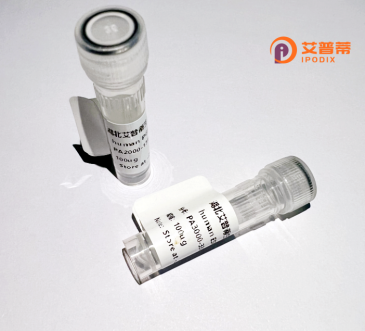
| 纯度 | >90%SDS-PAGE. |
| 种属 | Human |
| 靶点 | TRAM2 |
| Uniprot No | Q15035 |
| 内毒素 | < 0.01EU/μg |
| 表达宿主 | E.coli |
| 表达区间 | 1-370 aa |
| 活性数据 | MAFRRRTKSYPLFSQEFVIHNHADIGFCLVLCVLIGLMFEVTAKTAFLFILPQYNISVPTADSETVHYHYGPKDLVTILFYIFITIILHAVVQEYILDKISKRLHLSKVKHSKFNESGQLVVFHFTSVIWCFYVVVTEGYLTNPRSLWEDYPHVHLPFQVKFFYLCQLAYWLHALPELYFQKVRKEEIPRQLQYICLYLVHIAGAYLLNLSRLGLILLLLQYSTEFLFHTARLFYFADENNEKLFSAWAAVFGVTRLFILTLAVLAIGFGLARMENQAFDPEKGNFNTLFCRLCVLLLVCAAQAWLMWRFIHSQLRHWREYWNEQSAKRRVPATPRLPARLIKRESGYHENGVVKAENGTSPRTKKLKSP |
| 分子量 | 69.7 kDa |
| 蛋白标签 | GST-tag at N-terminal |
| 缓冲液 | PBS, pH7.4, containing 0.01% SKL, 1mM DTT, 5% Trehalose and Proclin300. |
| 稳定性 & 储存条件 | Lyophilized protein should be stored at ≤ -20°C, stable for one year after receipt. Reconstituted protein solution can be stored at 2-8°C for 2-7 days. Aliquots of reconstituted samples are stable at ≤ -20°C for 3 months. |
| 复溶 | Always centrifuge tubes before opening.Do not mix by vortex or pipetting. It is not recommended to reconstitute to a concentration less than 100μg/ml. Dissolve the lyophilized protein in distilled water. Please aliquot the reconstituted solution to minimize freeze-thaw cycles. |
以下是关于重组人TRAM2蛋白的三条参考文献,涵盖其功能及相关研究:
---
1. **文献名称**:*TRAM2 interacts with endoplasmic reticulum Ca²⁺-ATPase SERCA2b to promote collagen secretion*
**作者**:Kanaji, S. et al.
**摘要**:该研究发现TRAM2与内质网钙泵SERCA2b相互作用,通过维持内质网钙稳态促进胶原蛋白I的折叠和分泌,重组TRAM2的过表达可挽救胶原分泌缺陷细胞的表型。
2. **文献名称**:*TRAM2 mutations disrupt collagen secretion and cause osteogenesis imperfecta*
**作者**:Pekkarinen, T. et al.
**摘要**:研究通过全外显子测序鉴定出TRAM2突变导致成骨不全症,实验显示突变细胞中胶原蛋白的分泌显著减少,重组TRAM2蛋白可部分恢复患者成纤维细胞的胶原分泌能力。
3. **文献名称**:*TRAM2 regulates lipid homeostasis by modulating SREBP signaling*
**作者**:Zhang, Y. et al.
**摘要**:TRAM2通过调控SREBP通路影响脂质合成,重组TRAM2蛋白的体外实验揭示其与脂质转运蛋白的结合,进而调节内质网脂代谢及分泌过程。
---
以上文献涵盖了TRAM2在胶原分泌、疾病关联及脂代谢中的功能,均涉及重组蛋白的实验验证。如需具体文献来源,建议通过PubMed或Google Scholar进一步检索。
TRAM2 (Translocation-Associated Membrane Protein 2) is an endoplasmic reticulum (ER)-resident membrane protein implicated in protein translocation and lipid metabolism. It shares structural homology with TRAM1. a component of the Sec61 translocon complex that facilitates protein transport into the ER. TRAM2 is thought to assist in the biosynthesis and membrane integration of specific transmembrane proteins, possibly by interacting with the Sec61 machinery or modulating its activity.
Emerging studies highlight its role in lipid homeostasis, particularly in regulating cholesterol and triglyceride metabolism. TRAM2 interacts with enzymes involved in lipid biosynthesis and may influence lipid droplet formation, linking it to metabolic disorders such as atherosclerosis and hepatic steatosis. Additionally, TRAM2 is implicated in cellular stress responses, including ER stress and autophagy, suggesting its broader regulatory functions in maintaining ER proteostasis.
Expressed ubiquitously but enriched in metabolically active tissues (e.g., liver, brain), TRAM2's dysregulation has been associated with neurodegenerative diseases and cancer progression. While its exact molecular mechanisms remain under investigation, TRAM2 is proposed to act as a scaffold or signaling hub, coordinating protein-lipid interactions critical for cellular health. Ongoing research aims to clarify its therapeutic potential in metabolic and age-related pathologies.
×